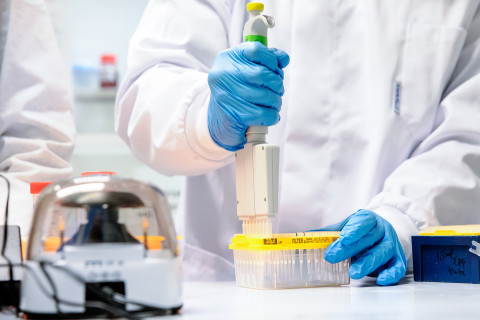Examining cortical biopsy samples from living individuals, researchers discovered early Alzheimer’s disease-associated cellular changes in three cell types. The unique study design of the Neuroscience Research Community at the University of Eastern Finland was used in collaboration with the US-based Broad Institute.
Early cellular changes associated with Alzheimer’s disease were examined in fresh cortical biopsy samples collected from patients with normal pressure hydrocephalus, NPH, in connection with shunt placement surgeries performed at Kuopio University Hospital. The patients exhibited varying levels of Alzheimer’s pathology, which is common in NPH. A similar study design has not been used in Alzheimer’s research before. The results were published in the prestigious Cell journal.
Traditionally, the mechanisms of Alzheimer’s disease have been studied mainly in post-mortem brain biopsy samples from humans, as well as in animal models of the disease, which means that early cellular level changes in the human brain remain poorly understood. From the treatment and prevention point of view, however, it is vital to understand particularly these early changes.
In the new study, snRNA sequencing was used to analyse the overall expression of genes in individual cell types in biopsy samples collected from NPH patients. The findings were compared with patient records and with previous single cell studies conducted in post-mortem human samples and animal models.
This allowed for the identification of pathogenic changes, which the researchers refer to as the early cortical amyloid response, and which occurred simultaneously with early β-amyloid changes. The early cortical amyloid response involved changes in gene expression in three different cell types. In excitatory neurons, the researchers observed hyperactivation and increased metabolism, while microglia, i.e., brain immune cells, showed activation of signalling pathways associated with β-amyloid removal and tissue damage repair. In addition, the expression of genes relevant to β-amyloid production increased both in neurons and oligodendrocytes.
In addition, electrophysiological experiments were performed on the samples to examine the electrophysiological functions of cells. These experiments, too, showed increased hyperactivation of cortical neurons in biopsy slices showing changes typical of early Alzheimer’s disease. In previous studies in animal models, neuronal hyperactivity has been found to have harmful effects on brain function and is believed to predict neuronal cell death as Alzheimer’s disease progresses. However, it has not been possible, until now, to study these mechanisms in human cortical tissue, as functional measurements are not possible in post-mortem biopsy samples.
New study design also promotes the development of pharmacotherapies and diagnostics
“The findings of this study will promote the development of new therapies and individualised diagnostics for Alzheimer’s disease. They also reinforce the recent view of genetics that microglia and other neuroglia of the brain play a more important role in the early stages of Alzheimer’s disease than previously thought,” says Professor Mikko Hiltunen, Director of the Molecular Genetics of Alzheimer’s Disease Research Group at the University of Eastern Finland.
According to Hiltunen, the study design, based on fresh cortical biopsy samples, has also opened up a unique opportunity to investigate the biological mechanisms of risk genes associated with Alzheimer’s disease.
NPH is caused by abnormal build-up of cerebrospinal fluid and treated with shunt placement surgery, which also allows for the collection of samples from the brain of a living individual.
“A cortical biopsy sample also helps in the assessment of the patient’s prognosis, for example regarding the risk of Alzheimer’s disease. The development of biological precision treatments that target disease mechanisms also highlights the importance of tissue samples,” Professor of Neurosurgery Ville Leinonen says.
“A functional, molecular and structural analysis of the same, living brain sample helps to understand the early cellular mechanisms of Alzheimer’s disease on several levels. By measuring the function of both individual neurons and neural networks, we can learn a lot about the early pathogenic changes,” says Professor Tarja Malm, Director of the Neuroinflammation Research Group, and the In Vitro and Ex Vivo Electrophysiology Core Facility, at the University of Eastern Finland.
The study constitutes part of Malm’s ERC Consolidator Grant project funded by the European Research Council.
For further information, please contact:
Professor Ville Leinonen, tel. +358 44 7172303, ville.leinonen (at) uef.fi, ville.leinonen (at) kuh.fi
University of Eastern Finland, Institute of Clinical Medicine, Kuopio
Kuopio University Hospital
Professor Tarja Malm, tel. +358 40 3552209, tarja.malm (at) uef.fi
University of Eastern Finland, A.I. Virtanen Institute for Molecular Sciences, Kuopio
Professor Mikko Hiltunen, tel. +358 40 3552014, mikko.hiltunen (at) uef.fi
University of Eastern Finland, Institute of Biomedicine, Kuopio
Research article:
Early Alzheimer's disease pathology in human cortex involves transient cell states. Gazestani V, Kamath T, Nadaf NM, Dougalis A, Burris SJ, Rooney B, Junkkari A, Vanderburg C, Pelkonen A, Gomez-Budia M, Välimäki NN, Rauramaa T, Therrien M, Koivisto AM, Tegtmeyer M, Herukka SK, Abdulraouf A, Marsh SE, Hiltunen M, Nehme R, Malm T, Stevens B, Leinonen V, Macosko EZ. Cell. 2023 Sep 28;186(20):4438-4453.e23. Early Alzheimer’s disease pathology in human cortex involves transient cell states - ScienceDirect
Neuroscience Research Community website: https://www.uef.fi/en/research-community/neuroscience-neuro
Neuroscience Research Community on X: https://twitter.com/UEFneuroscience


